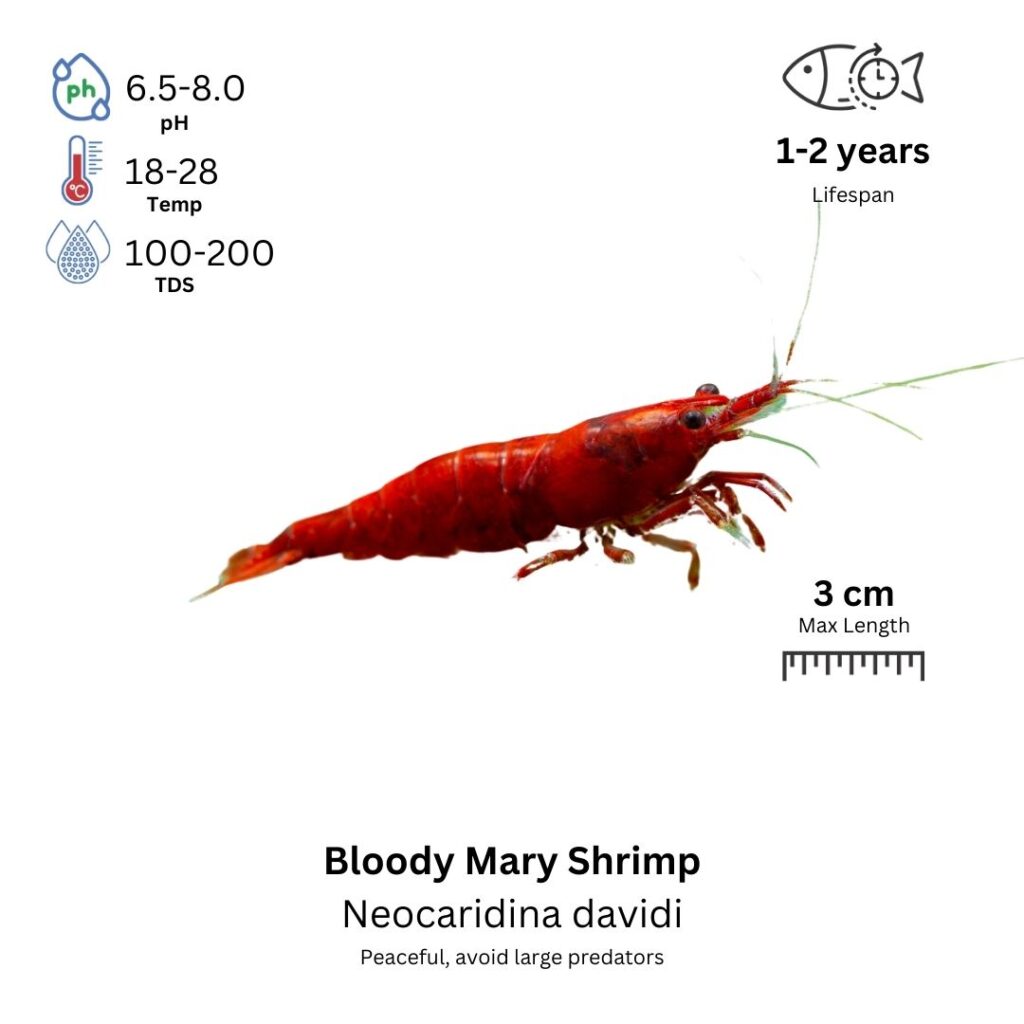Bloody Mary Shrimp
Neocaridina heteropoda

Description
The Bloody Mary Shrimp is a stunning and vibrant freshwater shrimp known for its deep red coloration. These shrimp are part of the Neocaridina davidi species, which is famous for its variety of color morphs, with the Bloody Mary variant being one of the most striking. Their bright red bodies can range from a deep crimson to a more translucent red, and the coloration is often uniform, though some individuals may have slight variations or lighter patches. Males are generally smaller and less intense in color compared to females, which tend to be slightly larger and rounder. Bloody Mary Shrimp are peaceful, social, and active, making them a popular addition to aquariums. They are excellent scavengers, helping to keep the tank clean by feeding on algae, detritus, and organic matter.
Habitat Origin
Native to freshwater habitats in East Asia, specifically from Taiwan. The Neocaridina species, including the Bloody Mary Shrimp, is known to inhabit a variety of environments, such as slow-moving streams, rivers, and ponds, where they thrive in soft, slightly acidic to neutral water with plenty of plants and hiding spots.
Aquarium
Ideal Number in Aquarium: At least 6 individuals, as they are social creatures and feel more secure in groups.
Favorite Food

Bloody Mary Shrimp are omnivores and will accept a variety of foods. In the wild, they feed on algae, biofilm, and small organic particles. In captivity, they can be fed high-quality shrimp pellets, algae wafers, blanched vegetables like zucchini and spinach, and occasional live or frozen foods like brine shrimp and daphnia. A varied diet will help ensure they maintain their health and vibrant coloration.
Behavior:
Bloody Mary Shrimp are peaceful, active, and social creatures. They spend much of their time scavenging and foraging for food on the substrate, plants, and decorations in the aquarium. They are excellent at cleaning up algae and leftover food, making them a useful addition to planted tanks or community aquariums. Although they are small, they are quite active and can be seen moving around the tank, interacting with their environment. Bloody Mary Shrimp are generally non-aggressive but may become shy or hide when stressed. It’s important to provide plenty of hiding spots and plants to make them feel secure.
Special Care:
Bloody Mary Shrimp are relatively hardy but require stable water conditions to thrive. They prefer soft, slightly acidic to neutral water, so it’s important to monitor water parameters regularly. Regular water changes and good filtration are essential to maintain clean water, as they are sensitive to poor water quality. Bloody Mary Shrimp are also sensitive to copper-based medications, which are toxic to them, so avoid using such treatments in their tank. They thrive in aquariums with plenty of live plants and hiding spots, which also help provide them with natural grazing areas.
Compatibility with Other Fish:
Yes, Bloody Mary Shrimp are compatible with most peaceful fish species that are small enough not to view them as food. They can be housed with other shrimp, small tetras, rasboras, and peaceful catfish. However, they should not be kept with larger or aggressive fish, as they may be eaten or harassed. Due to their small size, it’s important to house them with species that won’t stress them out or nip at their antennae or legs. They are ideal for aquariums that focus on small, peaceful species and are especially well-suited for planted tanks.
Breeding Setup
A dedicated breeding tank is highly recommended for Bloody Mary Shrimp to ensure controlled water parameters and prevent egg or fry predation. A 20-liter (5-gallon) tank is ideal, offering enough space while being easy to maintain. Maintain a pH between 6.5–7.5, temperature of 22–26°C (72–79°F), and GH of 6–12 dGH. Use a gentle sponge filter to avoid strong currents. Add fine sand or gravel, live plants (Java moss, Anubias), and floating plants (like duckweed) to offer cover and encourage natural behavior. Use moderate lighting to support plant growth without stressing the shrimp.
Conditioning for Breeding
Provide a varied omnivorous diet to condition the shrimp for breeding. Feed them high-quality shrimp pellets, algae wafers, blanched vegetables (e.g., zucchini), and occasional live foods such as brine shrimp or daphnia. This nutrient-rich diet enhances reproductive readiness. Maintain weekly water changes of 10–20% to keep the water stable and clean. Clean water reduces stress and promotes healthy egg development.
Spawning Process
Bloody Mary Shrimp typically reach sexual maturity between 3–6 months. When ready, the female carries 30–50 eggs under her abdomen in a visible greenish or yellow cluster. Fertilization occurs internally, and no additional intervention is required. The female incubates the eggs for 2–3 weeks, fanning them with her swimmerets to keep them oxygenated. Do not remove the female, as she does not harm her own eggs.
Fry Care
Upon hatching, shrimp fry are fully formed but very small and non-swimming. They begin foraging for food immediately. Their primary food sources are biofilm and microscopic algae, but you can also provide infusoria or liquid fry food. As they grow, offer baby brine shrimp or finely crushed pellets. Maintain daily water changes of 10–15%, keep the temperature stable between 22–26°C, and monitor ammonia, nitrite, and nitrate levels closely to ensure a safe environment.
Important Notes
Females are larger and rounder, especially when berried (carrying eggs), while males are slimmer and more active during mating. To avoid stress, maintain stable water conditions, avoid overcrowding, and do not house with aggressive fish. Bloody Mary Shrimp are sensitive to sudden parameter changes, so gentle maintenance and a peaceful environment are essential for successful breeding and fry survival.
